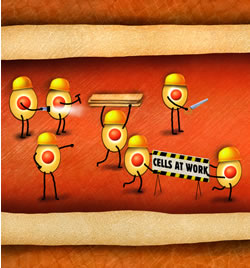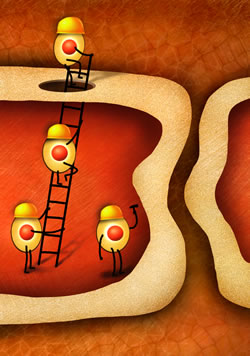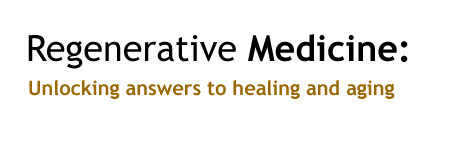Big idea


Scientists are optimistic about using adult stem cells to grow new tissues and repair damaged ones.





In this issue
Med-morphosis
Burden of proof
Big Idea:
Regenerative Medicine
Moving forward
Noteworthy
On Point:
Smallpox, big risks?

Story by Holly Korschun
Illustration by Dave Cutler
From artificial limbs to organ transplants to gene therapy, medical scientists are constantly developing innovative methods of human tissue repair. Until recently, these concepts were limited by the belief that once humans reach adulthood, they have most all the cells they will ever have. The exception was circulating blood cells, which are continuously replaced from progenitor cells in the bone marrow. If organs or tissues were damaged, scientists thought that only local cells could be recruited to help repair them.
Instead, recent discoveries show human tissues and organs may undergo continual repair and regeneration from cells that appear to originate in the adult bone marrow. These uncommitted cells receive signals from damaged or aging tissues that cause them to migrate to a particular location. They decide to become a certain kind of cell, such as a lung or heart or muscle cell -- much like a pool of uncommitted college freshmen who join different fraternities and sororities.
Teams of investigators throughout the Woodruff Health Sciences Center are part of the burgeoning field of stem cell research or "regenerative medicine." Embarking on numerous projects in cardiology, biomedical engineering, pulmonology, neuroscience, endocrinology, and hematology-oncology, scientists are optimistic that they might harvest uncommitted stem cells and use new technology to form new tissues and repair damaged ones.
"Regenerative medicine has the most potential of anything I've seen in my entire career," says Wayne Alexander, chair of the Department of Medicine. "It could lead to ways to manipulate cells to repair injuries -- from acute problems such as heart attack or stroke, or from other medical catastrophes such as acute hepatitis or respiratory distress syndrome. It's also relevant to aging of the immune system and to aging in general. For example, when an elderly person experiences minor physical trauma, it can take months to heal, while a toddler's scrape heals in days. This difference may reflect the difference in availability of adult stem cells.
"Our bone marrow most likely goes through a slow decrease in the production and delivery of regenerative cells," says Alexander. "That may explain the increase in cardiovascular disease and cancer among the elderly as well as degenerative diseases such as Parkinson's and Alzheimer's."
Hematology-oncologists were the earliest stem cell pioneers. For 20 years, with increasing success, they have been transplanting bone marrow into cancer patients as a "rescue" following whole-body irradiation or massive doses of chemotherapy designed to wipe out lethal tumors. The bone marrow contains hematopoietic stem cells that can regenerate the entire blood-forming system.
Several years ago investigators discovered that stem cells from week-old embryos can develop into any kind of cell in the bodymuscle, heart, skin, liver, lung, or others. However, the ethical controversies aroused by embryonic stem cells have led to an increased focus on adult bone marrow stem cells and other kinds of progenitor cells. There is still considerable uncertainty about how many of these cells are available, how capable they are of diverse differentiation, and how best to harvest, stimulate, and guide them. Cells that can turn into many different cell types are called pluripotent cells, and early cells with a restricted number of options are called progenitor cells.
Emory cardiologists are studying stem cells from mice, pigs, and humans for possible repair of blood vessels and heart muscle. Arshed Quyyumi, who came to Emory last year from the National Heart, Lung and Blood Institute, and others have discovered that the number of circulating progenitor endothelial cells that line our blood vessels corresponds to overall cardiovascular health.
Even presumably healthy people with no evident cardiovascular disease but who have low numbers of endothelial progenitor cells may have poor vascular function. "This helps explain why a lifelong smoker still could have a healthier cardiovascular system than a 35-year-old nonsmoker who suffers a heart attack," says Quyyumi. He plans to stimulate the growth of circulating endothelial progenitor cells by introducing growth factors into patients with cardiovascular disease.
When a blood vessel is blocked, scientists believe the bone marrow churns out progenitor cells that circulate in the bloodstream and help form alternative routes for blood flow. Following a heart attack, bone marrow-derived cells hone in on the damaged area and help revascularize and repair the damage. Emory cardiologist and biomedical engineer Zorina Galis is leading a multidisciplinary project with Emory and Georgia Tech scientists to create optimal laboratory conditions for growing stem cells dedicated to working in precise locations in the body. Other team members include cardiologist Quyyumi, hematology-oncologist Ned Waller, cardiothoracic surgeon Jake Vinten-Johansen, and engineers Andres Garcia and Carson Meredith.
In mice, the team will mimic cardiovascular disorders, then introduce engineered stem cells to repair the damage. They'll also use cultured adult stem cells to treat heart attacks in pigs. Their findings may translate into clinical therapies. By harvesting, culturing, and reintroducing a person's own cells, scientists hope to avoid the problems of tissue rejection and the need for immunosuppressive drugs.
"The potential of stem cell biology is tremendous, but the work is daunting," says Galis. "The field is so new that you run into a lot of 'magic recipes' and research that cannot be repeated. Our goal is to begin at the state of the art and bring more precise control and direction to the process."
Another diverse group of Emory scientists - biomedical engineer Michelle LaPlaca, neurologist Allan Levey, pharmacologist Stephen Traynelis, and hematology-oncologists Waller and David Archer - uses adult stem cells from mice to generate transplantable neural stem cells to treat traumatic brain injury and neurodegenerative disease. These researchers are collaborating with University of Minnesota scientist Catherine Verfaillie, whose experiments have created optimism about the promise of adult stem cell differentiation and usefulness. The Emory group also is comparing the effectiveness of embryonic stem cells and adult stem cells.
"Until recently we thought that a blood cell in the bone marrow was restricted to remaining a blood cell and making more blood cells," says Archer. "We are finding that isn't the case, but we still don't really know what makes a bone marrow cell become something else and how this is controlled. Defining these different cell populations is giving us the insight to look at the molecular mechanisms that govern these stem cells."
Researchers in many other Emory laboratories are studying mouse embryonic and adult stem cells in organs and tissues. In pulmonology, Kenneth Brigham is developing projects to culture and transplant hematopoietic stem cells and circulating endothelial cells to treat diseased lungs. Joe Le Doux in biomedical engineering and Collin Weber in surgery are turning mouse embryonic and adult stem cells into pancreatic islet cells to treat diabetes. Grace Pavlath in pharmacology is enlisting muscle precursor cells called satellite cells to try to regenerate muscles wasted by disease or disuse. Sam Dudley, a cardiologist at the VA, uses stem cells to repair heart tissue in mice. Marie Csete in anesthesiology is working with muscle-derived stem cells for use in Parkinson's disease therapy.
"Research with adult stem cells has important implications," emphasizes Wayne Alexander. "This may give us a source of the patient's own cells without the problems of immune rejection and none of the potential ethical or political difficulties associated with embryonic stem cells."
Holly Korschun is director of science communications for the Woodruff Health Sciences Center.
Copyright © Emory University, 2003. All Rights Reserved.
Send comments to the Editors.
Web version by Jaime Henriquez.